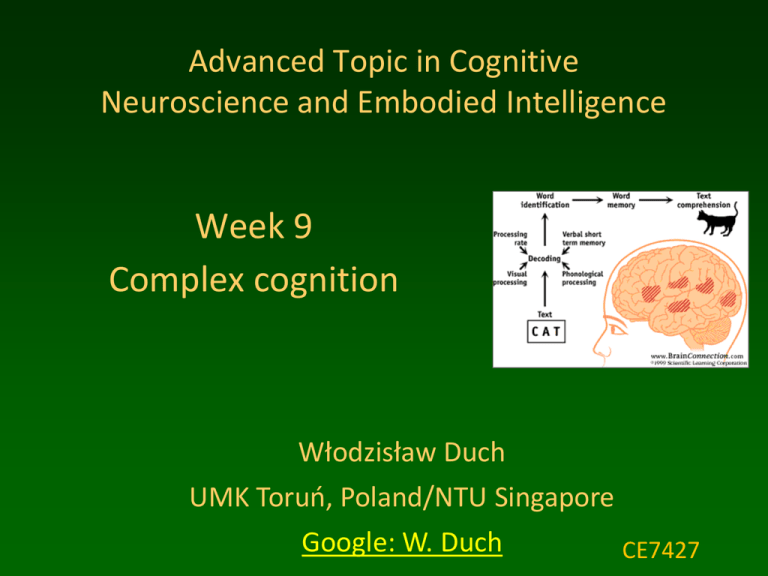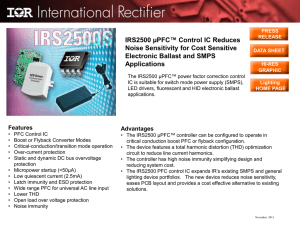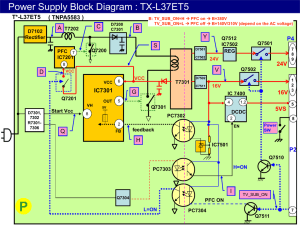CE7427: Cognitive Neuroscience and Embedded Intelligence
advertisement

Advanced Topic in Cognitive
Neuroscience and Embodied Intelligence
Week 9
Complex cognition
Włodzisław Duch
UMK Toruń, Poland/NTU Singapore
Google: W. Duch
CE7427
What it will be about
1.
2.
3.
4.
5.
How are the words and concepts represented in the brain?
Model of speech and reading.
Language impairments.
Gestalt of sentences
Advanced models of meaning.
Wyższe czynności
Na razie mamy sieciowe modele:
• Rozpoznające obiekty (wzrok, słuch, dotyk).
• Procesów uwagi, współdziałających z rozpoznawaniem.
• Pamiętające epizody, ogólne relacje semantyczne, utrzymujące bieżące
informacje.
• Uczące się wymowy i sensu słów.
Czego brakuje?
• Celów, dążeń, planowania.
• Rozumowania.
• Emocji.
• Podejmowania decyzji.
• Reprezentacji ego, modelu „ja”, samoświadomości.
• Wolnej woli?
• Relacji społecznych, hierarchii wartości.
Podstawy biologiczne
Uszkodzenia kory przedczołowej (PFC) jak i kory zakrętu obręczy (CC) wpływają
na planowanie, rozumowanie, podejmowanie decyzji, interakcje społeczne,
samoświadomość, działania intencjonalne.
Kora PFC i CC nie działa jednak w izolacji od reszty!
Czy jesteśmy automatami? Wolna wola, podmiotowość i mózg
(referat 3/2007).
Funkcje PFC
Pamięć robocza, dynamiczne
aktywacje nie ulegające
rozproszeniu.
Doświadczenia z opóźnionym dopasowywaniem wzorców.
PFC utrzymuje przez pewien czas informacje aktywując „pamięć roboczą”,
umożliwia to powracanie do wykonywanych zadań pomimo konieczności
wykonania innych działań, monitorowanie błędów, koordynację działań
celowych, planów, generowanie różnorodnych działań.
Stroop
Trudno jest wyhamować dobrze wytrenowane procesy rozpoznawania czy
działania (taniec, muzyka), np. w efekcie Stroopa: mamy podać kolor
kolejnych wyrazów, ale robimy to wolniej niż dla wyrazów nie związanych z
kolorami.
Model Stroopa
Rozpoznawanie słów bądź kolorów.
Wyniki są całkiem zgodne z doświadczeniem.
Jest sporo wariantów tego doświadczenia i możliwości śledzenia zmian w czasie
wielokrotnego powtarzania.
Stroop: kształty
Poziom fonologiczny: nieistniejące
słowa nie wzbudzają głębszych
obszarów.
Poziom głęboki: błędy fonologiczne i
semantyczne (kąt – kot, kot - pies),
pomyłki w rozpoznawaniu znaków.
Kolory i słowa prezentowane z przesunięciem
czasowym (stimulus onset asynchrony, SOA),
minus dla czytania słów = kolor przed
słowami, dla nazywania kolorów słowa przed
kolorem.
Stroop: wyniki SOA
Kolory słabo zaburzają czytanie słów (conflict vs. congruent), nawt jeśli kolory
pojawiają się przed słowami => zwykle nie nazywamy kolorów!
Efekt interferencji zanika jeśli słowa pojawiają się sporo po kolorze.
Nie wychodzi zwolnienie przy jednoczesnej prezentacji (garb po lewej),
zapewne bierze się to z konkurencji; wzrost w modelu dla SOA<0 też zły.
Dynamiczna kategoryzacja: WCS
Wisconsin card sort, często stosowany test, w którym reguły kategoryzacji mogą
się zmienić w czasie eksperymentu.
Do jakiej kategorii zaliczyć 3 gwiazdki? Czerwonych? Trojkątów?
WCS
A to?
Dynamiczna kategoryzacja
Do jakiej kategorii zaliczyć 4 krzyżyki?
Obiekty różnią się kształtem, kolorem i liczbą elementów.
Jeśli zmienić regułę, jak szybko badany to odkryje?
Wpływ uszkodzeń PFC
Dynamiczna kategoryzacja: pacjenci z uszkodzeniami kory przedczołowej
trzymają się pierwszej reguły i nie potrafią jej zmienić.
PFC utrzymuje reprezentację obecnej sytuacji, wymiaru nad którym należy się
skupić, co prowadzi do właściwej aktywacji uwagi.
PFC potrafi szybko zmienić reprezentację, ale pamięć synaptyczna w PC uczy się
wolniej, więc osoby z uszkodzeniami PFC będą dłużej trać przy regule, która
przestała działać.
Działania synaptyczne i dynamiczne
Decyzja jaki podjąć wybór
Kooperacja pamięci synaptycznej i dynamicznej.
Kategoryzacja dynamiczna
Decyzja jaki podjąć wybór: linie czy wypełnione kształty?
Zmiany mogą dotyczyć odwrócenia kategorii w tym samym wymiarze (ID) lub
zmiany wymiaru, który decyduje o kategorii (ED).
Kategoryzacja dynamiczna
Orbital = hamowanie afektywne
Lateral = wybór dzięki uwadze.
Albo ...
Orbital PFC: reprezentuje cechy,
boczna PFC abstrakcyjne wymiary.
Aktywacja PFC pozwala na zmianę
działania: PFC
orbitalne: nowe cechy (IDR)
Boczne: nowe wymiary (EDS)
Trwanie: wpływy synaptyczne przy braku dynamicznej aktywacji w PFC
Model IDE/ED
Uwaga: aktywacja
PFC: nadaje kierunek,
VTA działa jako adaptujący się
krytyk, powoduje zmiany w PFC
i daje nagrodę.
Trwanie: wpływy synaptyczne przy braku dynamicznej aktywacji w PFC
IDR/EDS w modelu
Trwanie: wpływy synaptyczne przy braku dynamicznej aktywacji w PFC
Model i doświadczenie
Trwanie: wpływy synaptyczne przy braku dynamicznej aktywacji w PFC
Mechanizmy PFC
Dynamiczna pamięć robocza: neurony PFC utrzymują swoją aktywację pozwalając
na jednoczesne wykonywanie kilku funkcji.
Monitorowanie/ocena wyników działań, sprzężona jest z dopaminoergicznym
mechanizmem nagrody.
Wydaje się, że właśnie te informacje stają się świadome, bo oceny muszą być
dostępne wszystkim obszarom mózgu by wpłynąć na procesy korekty.
Nieświadome uczenie skomplikowanych zachowań za pomocą biologicznych
środków opartych na mechanizmach nagrody i kary nie jest możliwe.
Świadomość musi powstać w każdym systemie dynamicznym, którego fizyczne
stany podlegają wewnętrznej ocenie.
Budowa świadomych robotów to tylko kwestia czasu.
Automatyzmy i kontrola
Dynamiczna pamięć robocza: neurony PFC utrzymują swoją aktywację pozwalając
na jednoczesne wykonywanie kilku funkcji.
Podsumowanie
Psychologia zmienia się całkowicie dzięki metodom neurokognitywnym!
Większość wyjaśnień dotychczas prezentowanych przez psychologów niewiele
naprawdę wyjaśnia, postulując mechanizmy, które nie istnieją.
Rzeczywistość nie jest taka prosta, jakby psycholodzy chcieli, ale za to znacznie
ciekawsza.
Przykład: kategoryzacja i odwrotne częstości z punktu widzenia modeli
neuronowych i z punktu widzenia psychologii.
Attractor neural networks and concept formation in psychological spaces.
Imagery and brains
How and where are mental images formed?
• Borst, G., Kosslyn, S. M, Visual mental imagery and visual perception:
structural equivalence revealed by scanning processes.
Memory & Cognition, 36, 849-862, 2008.
The present findings support the claim that image representations depict
information in the same way that visual representations do.
• Cui, X et al. (2007) Vividness of mental imagery: Individual variability can be
measured objectively. Vision Research, 47, 474-478.
Reported Vividness of Visual Imagination (VVIQ) correlates well with the early
visual cortex activity relative to the whole brain activity measured by fMRI
(r=-0.73), and the performance on a novel psychophysical task.
Findings emphasize the importance of examining individual subject variability.
Poor perceptual imagery: why? Weak top-down influences?
Unable to draw from memory, describe details, faces, notice changes, etc.
What is needed for imagery?
Sensory cortex, for example V4 for color, MT for movement.
Bottom-up and top-down activations create resonant states.
What if top-down connections are weak or missing?
C. Gilbert, M. Sigman, Brain States: Top-Down Influences in Sensory Processing.
Neuron 54(5), 677-696, 2007
Cortical & thalamic sensory processing are subject to powerful top-down
influences, the shaping of lower-level processes by more complex information.
Cortical areas function as adaptive processors, being subject to attention,
expectation, and perceptual task. Brain states are determined by the
interactions between multiple cortical areas and the modulation of intrinsic
circuits by feedback connections.
Disruption of this interaction may lead to behavioral disorders.
Dehaene et al, Conscious, preconscious, and subliminal processing, TCS 2006
Bottom-up strength & top-down attention combined leads to 4 brain states with
both stimulus and attention required for conscious reportability. No imagery?
Hidden concepts
• Language, symbols in the brain: phonological labels associated with protypes
of distributed activations of the brain.
Helps to structure the flow of brain states in the thinking process.
Do we have conscious access to all brain states that influence thinking?
Right hemisphere activations just give us the feeling wrong something here.
• Right hemisphere is as busy as left – concepts without verbal labels?
• Evidence: insight phenomena, intuitive understanding of grammar, etc.
Can we describe verbally natural categories?
• Yes, if they are rather distinct: see 20 question game.
• Is object description in terms of properties sufficient and necessary?
• Not always. Example: different animals and dog breeds.
• 20Q-game: weak question (seemingly unrelated to the answer) may lead to
precise identification! RH may contribute to activation enabling associations
Problems requiring insights
Given 31 dominos
and a chessboard with 2 corners
removed, can you cover all board with dominos?
Analytical solution: try all combinations.
Does not work … to many combinations to try.
Logical, symbolic approach has
little chance to create proper
activations in the brain, linking
new ideas: otherwise there will be
too many associations, making
thinking difficult.
Insight <= right hemisphere, metalevel representations without
phonological (symbolic)
components ... counting?
chess board
domino
n
black
white
m
d o
o
i
phonological reps
Insights and brains
Activity of the brain while solving problems that required insight and that
could be solved in schematic, sequential way has been investigated.
E.M. Bowden, M. Jung-Beeman, J. Fleck, J. Kounios, „New approaches to
demystifying insight”. Trends in Cognitive Science 2005.
After solving a problem presented in a verbal way subjects indicated themselves
whether they had an insight or not.
An increased activity of the right hemisphere anterior superior temporal gyrus
(RH-aSTG) was observed during initial solving efforts and insights. About 300 ms
before insight a burst of gamma activity was observed, interpreted by the authors
as „making connections across distantly related information during comprehension
... that allow them to see connections that previously eluded them”.
Insight interpreted
What really happens? My interpretation:
• LH-STG represents concepts, S=Start, F=final
• understanding, solving = transition, step by step,
from S to F
• if no connection (transition) is found this leads to an impasse;
• RH-STG ‘sees’ LH activity on meta-level, clustering concepts into abstract
categories (cosets, or constrained sets);
• connection between S to F is found in RH, leading to a feeling of vague
understanding;
• gamma burst increases the activity of LH representations for S, F and
intermediate configurations; feeling of imminent solution arises;
• stepwise transition between S and F is found;
• finding solution is rewarded by emotions during Aha! experience;
they are necessary to increase plasticity and create permanent links.
Solving problems with insight
Neuromodulation (emotions)
Goal
Steps
Start: problem statement
Left temporal lobe
Right temporal
lobe
Dog breeds
329 breeds in 10 categories:
Sheepdogs and Cattle Dogs; Pinscher and
Schnauzer; Spitz and Primitive; Scenthounds;
Pointing Dogs; Retrievers, Flushing Dogs and Water
Dogs; Companion and Toy Dogs; Sighthounds
Write down properties and try to use them in the
20-question game to recognize the breed … fails!
Visually each category is quite different,
all traditional categorizations are based on
behavious and features that are not easy to
observe.
• Ontologies do not agree with visual similarity.
• Brains discover it easily => not all brain states
have linguistic labels.
Dog behavior
Energies of trajectories
P.McLeod, T. Shallice, D.C. Plaut,
Attractor dynamics in word recognition: converging evidence from errors by
normal subjects, dyslexic patients and a connectionist model.
Cognition 74 (2000) 91-113.
New area in psycholinguistics: investigation of dynamical cognition, influence of
masking on semantic and phonological errors.
How to become an expert?
Textbook knowledge in medicine: detailed description of all possibilities.
Effect: neural activation flows everywhere and correct diagnosis is impossible.
Correlations between observations forming prototypes are not firmly established.
Expert has correct associations.
Example: 3 diseases, clinical case description, MDS description.
1) System that has been trained on textbook knowledge.
2) Same system that has learned on real cases.
3)
Experienced
expert that
has learned of
on knowledge
real cases. in complex domains
Conclusion:
abstract
presentation
leads to poor expertise, random real case learning is a bit better,
learning with real cases that cover the whole spectrum of different
cases is the best.
I hear and I forget.
I see and I remember.
I do and I understand.
Mental models
Kenneth Craik, 1943 book “The Nature of
Explanation”, G-H Luquet attributed mental models
to children in 1927.
P. Johnson-Laird, 1983 book and papers.
Imagination: mental rotation, time ~ angle, about 60o/sec.
Internal models of relations between objects, hypothesized to play a major role
in cognition and decision-making.
AI: direct representations are very useful, direct in some aspects only!
Reasoning: imaging relations, “seeing” mental picture, semantic?
Systematic fallacies: a sort of cognitive illusions.
• If the test is to continue then the turbine must be rotating fast enough to
generate emergency electricity.
• The turbine is not rotating fast enough to generate this electricity.
• What, if anything, follows? Chernobyl disaster …
If A=>B; then ~B => ~A, but only about 2/3 students answer correctly..
Mental models summary
The mental model theory is an alternative to the view that
deduction depends on formal rules of inference.
1. MM represent explicitly what is true, but not what is false;
this may lead naive reasoner into systematic error.
2. Large number of complex models => poor performance.
3. Tendency to focus on a few possible models => erroneous conclusions and
irrational decisions.
Cognitive illusions are just like visual illusions.
M. Piattelli-Palmarini, Inevitable Illusions: How Mistakes of Reason Rule Our
Minds (1996)
R. Pohl, Cognitive Illusions: A Handbook on Fallacies and Biases in Thinking,
Judgement and Memory (2005)
Amazing, but mental models theory ignores everything we know about
learning in any form! How and why do we reason the way we do?
I’m innocent! My brain made me do it!
Mental models
Easy reasoning A=>B, B=>C, so A=>C
• All mammals suck milk.
• Humans are mammals.
• => Humans suck milk. Simple associative process, easy to simulate.
... but almost no-one can draw conclusion from:
• All academics are scientist.
• No wise men is an academic.
• What can we say about wise men and scientists?
Surprisingly only ~10% of students get it right after days of thinking.
No simulations explaining why some mental models are so difficult.
Why is it so hard? What really happens in the brain?
Try to find a new point of view to illustrate it.
Learning complex categories
Categorization is quite basic, many psychological models/experiments.
Multiple brain areas involved in different categorization tasks.
Classical experiments on rule-based category learning:
Shepard, Hovland and Jenkins (1961), replicated by Nosofsky et al. (1994).
• Problems of increasing complexity; results determined by logical rules.
• 3 binary-valued dimensions: shape (square/triangle), color (black/white)
•
•
•
•
•
•
and size (large/small), with 4 objects in each category.
Type I - categorization using one dimension only.
Type II - two dim. are relevant, including exclusive or (XOR) problem.
Types III, IV, and V - intermediate complexity between Type II - VI.
All 3 dimensions relevant, "single dimension plus exception" type.
Type VI - most complex, 3 dimensions relevant, enumerate, no simple rule.
Difficulty (number of errors made): Type I < II < III ~ IV ~ V < VI
For n bits there are 2n binary strings 0011…01; how complex are the rules
(logical categories) that human/animal brains still can learn?
Canonical neurodynamics.
What happens in the brain during category learning?
Complex neurodynamics <=> simplest, canonical dynamics.
For all logical functions one may write corresponding equations.
For XOR (type II problems) equations are:
V x, y, z 3 xyz
1 2
2
2 2
x
y
z
4
V
3 yz x 2 y 2 z 2 x
x
V
y
3 xz x 2 y 2 z 2 y
y
V
z
3 xy x 2 y 2 z 2 z
z
x
Corresponding feature space for relevant dimensions
A, B has 3 dimensions and 4 attractors.
Inverse based rates
Relative frequencies (base rates) of
categories are used for classification:
if on a list of disease and symptoms disease
C associated with (PC, I) symptoms is 3 times
more common as R, then symptoms
PC => C, I => C (base rate effect).
Predictions contrary to the base:
inverse base rate effects (Medin, Edelson).
Although PC + I + PR => C (60% answers)
PC + PR => R
(60% answers)
Why irrelevant symptoms make such difference?
Psychological explanations are not convincing. Thinking is
brain state evolution. Strange effects may result from the
neurodynamics of learning.
So far there are no dynamical models of such effects.
IBR neurocognitive explanation
Psychological explanation:
J. Kruschke, Base Rates in Category Learning (1996).
PR is attended to because it is a distinct symptom, although PC is more
common.
Basins of attractors result from
neurodynamics defined in high-D space.
Consider PDFs in P-space {C, R, I, PC, PR}.
If PR + PC activation leads more frequently
to R the basin of attractor for R is deeper.
Construct neurodynamics, get PDFs.
Unfortunately these processes are in 5D.
Prediction: weak effects due to order and timing of presentation
(PC, PR) and (PR, PC), due to trapping of the mind state by different attractors.
Learning
Point of view
Neurocognitive
Psychology
I+PC more frequent => stronger
synaptic connections, larger and
deeper basins of attractors.
Symptoms I, PC are typical for C
because they appear more often.
To avoid attractor around I+PC
leading to C, deeper, more localized
attractor around I+PR
is created.
Rare disease R - symptom I is
misleading, attention shifted to PR
associated with R.
Probing
Point of view
Neurocognitive
Activation by I leads to C because
longer training on I+PC creates larger
common basin than I+PR.
Psychology
I => C, in agreement with base rates,
more frequent stimuli I+PC are
recalled more often.
Activation by I+PC+PR leads
I+PC+PR => C because all symptoms
frequently to C, because I+PC puts
are present and C is more frequent
the system in the middle of the large (base rates again).
C basin and even for PR geadients still
lead to C.
Activation by PR+PC leads more
frequently to R because the basin of
attractor for R is deeper, and the
gradient at (PR,PC) leads to R.
PC+PR => R because R is distinct
symptom, although PC is more
common.
Mental model dynamics
Why is it so hard to draw conclusions from:
• All academics are scientist.
• No wise men is an academic.
• What can we say about wise men and scientists?
All A’s are S, ~ W is A; relation S <=> W ?
What happens with neural dynamics?
Basins of A is larger than B, as B is a subtype of A, and thus has to inherit most
properties that are associated with A.
Attractor for B has to be within A.
Thinking of B makes it hard to think of A, as the
Wise men
Scientists
Basins of attractors for the
3 concepts involved;
basin for “Wise men” has unknown
relation to the other basins.
Academics





